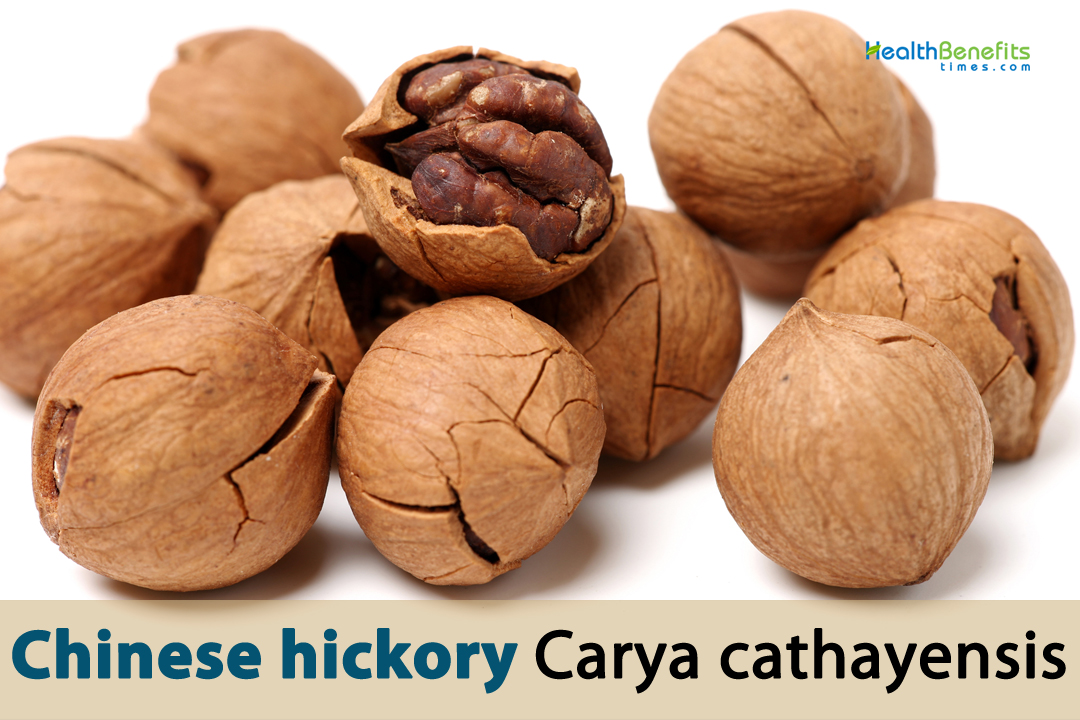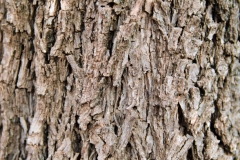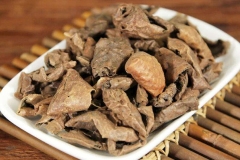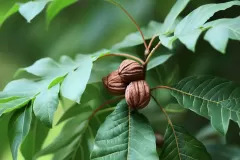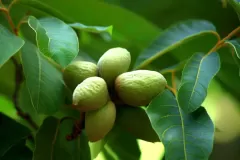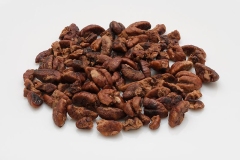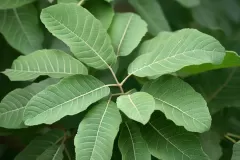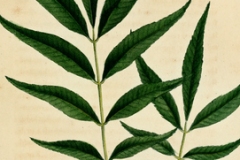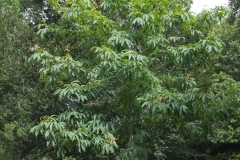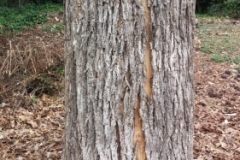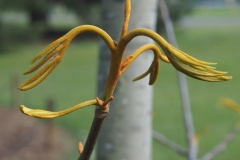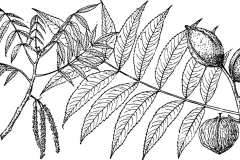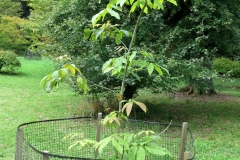| Chinese hickory Quick Facts | |
|---|---|
| Name: | Chinese hickory |
| Scientific Name: | Carya cathayensis |
| Origin | China, particularly in regions such as Sichuan, Hubei, and Yunnan |
| Colors | Initially green turning to brown or dark brown as they mature |
| Shapes | Hard-shelled nut, roughly spherical in shape, around 1 to 1.5 cm (0.4 to 0.6 inches) in diameter |
| Taste | Rich, buttery taste |
| Major nutrients | • Healthy Fats • Protein • Dietary Fiber • Vitamin E • Vitamin B6 • Magnesium • Phosphorus • Manganese • Copper • Antioxidants • Phytosterols • Carbohydrates |
| Health benefits | Rich in Nutrients, Healthy Fats, Heart Health, Weight Management, Blood Sugar Control, Bone Health, Brain Health, Digestive Health, Skin Health, Allergy Tolerance |
| Name | Chinese hickory |
|---|---|
| Scientific Name | Carya cathayensis |
| Native | China, particularly in regions such as Sichuan, Hubei, and Yunnan |
| Common Names | Cathay nut, Chinese pignut, Chinese bitternut hickory, Himalayan hickory, Yashima walnut, Chinese nutmeg-yew, Chinese walnut hickory, Chinese shagbark hickory, Yashima hickory, Chinese hickory nut, Chinese walnut, Chinese water hickory, Cathay pecan, Cathay hickory |
| Name in Other Languages | Arabic: Jawz alhikuri alsini (جوز الهيكوري الصيني), Joz al-hikori al-Sini, Jawz sayni (جوز صيني) Assamese: Chainij Hikori (চাইনিজ হিকৰি) Bengali: Cīnā hikari (চীনা হিকরি), Chīn ākhroṭ (চীন আখরোট), Chainij Hikori (চাইনিজ হিকোরি) Bhili: Chāynīz Hikorī (ચાયનીઝ હિકોરી) Bodo: Chainij Hikori (চাইনিজ হিকৰি) Bulgarian: Kitayski oreh (Китайски орех) Chhattisgarhi: Chainīz Hikorī (चाइनीज हिकोरी) Chinese: Zhōngguó shān hétáo (中國山核桃), Shan he tao (山核桃), Xiǎo hétáo (小核桃), Shān xiè (山蟹), Hétáo (核桃), Yě qīshù (野漆树), Yama kaku tōjin (山核桃仁), Shān hétáo pí (山核桃皮), Shān hétáo yè (山核桃叶) Croatian: Kineski orah Czech: Čínský ořech Danish: Kinesisk hickory Dogri: Chinese Hickory (چائنيز هکوري) Dutch: Chinese hickorynoot English: Chinese Hickory, Cathay hickory Estonian: Hiina pähkel Filipino: Tsina walnut, Chineseng hickory Finnish: Kiinanpähkinä French: Noyer de Chine Garo: Chinese Hickory German: Chinesische Hickorynuss, Chinahickory Greek: Kinezikó karýdi (Κινεζικό καρύδι) Gujarati: Chā’inīza ākharoṭ (ચાઇનીઝ આખરોટ), Chāyanīza Hikorī (ચાયનીઝ હિકોરી) Hebrew: Egoz hayikori hasini (אגוז היקורי הסיני) Hindi: Cheenī akhroṭ (चीनी अखरोट), Chīnī Hikorī (चीनी हिकोरी), Chāinīz Hikorī (चाइनीज हिकोरी) Hungarian: Kínai dió Icelandic: Kínversk hikornhneta Indonesian: Kenari Cina Italian: Noce cinese Japanese: Chainīzu hikkorī (チャイニーズヒッコリー), Yashima kurumi (ヤシマクルミ) Kannada: Chainīs akroṭ (ಚೈನೀಸ್ ಅಕ್ರೋಟ್), Chainīs hikkori (ಚೈನೀಸ್ ಹಿಕ್ಕೊರಿ) Kashmiri: Chinese Hickory (چائنيز هکوري) Khasi: Chinese Hickory Kokborok: Chainij Hikori (চাইনিজ হিকরি) Konkani: Chainīz Hikorī (चायनीज हिकोरी) Korean: Jungguk pungdanpung (중국풍단풍) Kutchi: Chāynīz Hikorī (ચાયનીઝ હિકોરી) Lithuanian: Kininis riešutas Latvian: Ķīnas rieksts Maithili: Chainij Hikori (चाइनिज हिकोरी) Malay: Kacang Cina, Kacang Hickory Cina, Cina Hickory Malayalam: Cainīs hikkari (ചൈനീസ് ഹിക്കറി), Chainīs Hikkari (ചൈനീസ് ഹിക്കറി) Manipuri: Chainij Hikori (চাইনিজ হিকরি) Marathi: Chāynīsa Hikorī (चायनीस हिकोरी) Mizo: Chinese Hickory Nepali: Chainij Hikori (चाइनिज हिकोरी) Norwegian: Kinesisk hickorynøtt Odia: Chainij Hikori (ଚାଇନିଜ୍ ହିକୋରୀ) Persian: Gerdu-ye chini (گردوی چینی) Polish: Orzech chiński Portuguese: Noz-chinesa Punjabi: Cīnī Hikorī (ਚੀਨੀ ਹਿਕੋਰੀ), Chā’īnīza Hikorī (ਚਾਈਨੀਜ਼ ਹਿਕੋਰੀ) Romanian: Nucă chineză Russian: Kitayskiy orekh (Китайский орех), Kitayskiy gikori (Китайский гикори) Sanskrit: Chīnī Hikorī (चीनी हिकोरी) Santali: Chainij Hikori (চাইনিজ হিকৰি) Serbian: Kineski orah (Кинески орех) Sikkimese: Chinese Hickory (ཅནར ཧི་ཁོ་རི) Sindhi: Chinese Hickory (چائنيز هکوري) Slovak: Čínska hikorie Slovenian: Kitajska oreščina Spanish: Nuez china Swahili: Nazi la Kichina Swedish: Kinesisk hickory Tamil: Cīṉa akroṭ (சீன அக்ரோட்), Sīṉa Hikkari (சீன ஹிக்கரி) Telugu: Caina ākulu (చైనా ఆకులు), Cainīs hikkōrī (చైనీస్ హిక్కోరీ), Chainīs Hikorī (చైనీస్ హికోరీ) Thai: Phlạbphlā cīn (พลับพลาจีน), Makhāy lā (มะคายลา), Mamuang hak (มะม่วงหัก) Tulu: Chainīs Hikori (ಚೈನೀಸ್ ಹಿಕೊರಿ) Turkish: Çin cevizi, Çin ceviz Ukrainian: Kytaysʹkyy hiyoriy (Китайський гікорій), Kitays’ka gikoriya (Китайська гікорія) Urdu: Chīnī Hikorī (چینی ہکوری), Chinese Hickory (چائنیز ہکوری) Vietnamese: Hạt hồ tiêu Trung Quốc, Hạt hickory Trung Quốc Welsh: Hicoria Tsieineaidd |
| Plant Growth Habit | Medium-sized deciduous tree |
| Growing Climates | Narrow moist valleys, foot of mountains, broadleaf deciduous forests, forests on mountain slopes, banks of rivers, river valleys, mountainous areas, hillsides, slopes, mixed woodland communities, agricultural land |
| Soil | Well-drained, deep, and fertile soils are crucial. They prefer loamy soils with good moisture retention but excellent drainage. Soil pH should ideally be slightly acidic to neutral |
| Plant Size | Up to 50 to 100 feet (15 to 30 meters) or more |
| Root | Develop a primary taproot and later lateral roots develop from the taproot |
| Stem | Trunk is the central, upright, and main stem of the Chinese hickory tree. It serves as the primary support structure for the tree |
| Bark | Greenish, smooth and thin when young turning to rougher and develops furrows or deep ridges as they mature |
| Leaf | Pinnately compound, consisting of multiple leaflets arranged along a central stem. Leaflets are about 3 to 6 inches (7.5 to 15 cm) long and 1 to 2 inches (2.5 to 5 cm) wide |
| Flowering season | April to May |
| Pollinators | Wind |
| Flower | Produce inconspicuous flowers in catkins. The male and female flowers are on the same tree and rely on wind pollination. Female flowers develop into hickory nuts |
| Fruit Shape & Size | Hard-shelled nut, roughly spherical in shape, around 1 to 1.5 cm (0.4 to 0.6 inches) in diameter with a thick and woody outer shell |
| Fruit Color | Initially green turning to brown or dark brown as they mature |
| Seed | Relatively small, measuring around 1 to 1.5 cm (0.4 to 0.6 inches) in diameter |
| Flavor/Aroma | Sweet and nutty fragrance |
| Taste | Rich, buttery taste |
| Plant Parts Used | Bark, leaves, Nuts |
| Propagation | By Seeds, by grafting, hardwood cuttings |
| Lifespan | About 100 to 200 years or more when grown in favorable conditions |
| Season | September to October |
| Major Nutrition |
|
| Health benefits |
|
| Available Forms |
|
Plant Description
Chinese hickory is classified as a medium-sized deciduous tree and typically attains a height of 50 to 100 feet (15 to 30 meters), thereby establishing itself as a sizable specimen featuring a broadly elliptical to rounded canopy. Narrow moist valleys, mountain foothills, broadleaf deciduous forests, banks of rivers, river valleys, mountainous regions, slopes, agricultural land, and slopes are all habitats where this plant is observed to thrive. Fertile, deep, well-drained soils are essential. They have a preference for loamy soils that retain moisture well but have excellent drainage.
The nutritional value of Chinese hickory nuts is highly regarded, as they contain an abundance of protein, healthful fats, vitamins, and minerals. A variety of vitamins and minerals are also present, such as calcium, magnesium, and vitamin E. In addition to being a prevalent snack food in China, they are utilized in an assortment of dishes. Roasted and salted, they can be incorporated into traditional dishes, baked goods, and confections. The wood is significantly esteemed for its robustness and longevity. It is utilized in a variety of woodworking applications, including the construction of musical instruments such as pianos and furniture. In general, Chinese hickory is a multipurpose and economically and culinary significant tree species.
Roots
The primary taproot that Chinese hickory trees typically develops extends in a vertical downward direction. As the Chinese hickory tree reaches maturity, the taproot gives way to lateral roots. A multitude of fine, fibrous roots emerge from the lateral roots in close proximity to the soil’s surface. These fibrous roots absorb water and nutrients from the topsoil with remarkable efficiency. Adventitious root development may also occur in Chinese hickory trees as a response to environmental stressors or conditions. These roots form on branches, stems, and even the tree’s uppermost portions; they aid in resource acquisition and stability.
Stem
The primary trunk is the vertical, central stem that ascends from the soil. It facilitates the transportation of water and nutrients from the tree’s roots to its upper portions and provides structural support for the entire tree. Branch protrusion in diverse orientations is abundant from the primary trunk. The branches of the tree provide support for its foliage, blooms, and fruits.
The stem contains specialized tissues that are accountable for the transportation of nutrients and water. From the roots to the leaves, xylem tissue transports water and minerals, whereas phloem tissue transports the byproducts of photosynthesis (sugars and other organic compounds) from the leaves to different portions of the tree.
Bark
The bark of Chinese hickory trees is typically greenish in hue, relatively smooth, and thin. As trees progress in age, their bark develops furrows or deep ridges and becomes coarser. The bark’s surface acquires a discernible texture due to the furrows. As the bark ages, its hue changes from greenish to gray or brown. The development of vertical fissures in the bark may contribute to its overall rough aspect. As the size and age of the tree increase, so does the girth of its bark. The underlying vascular tissues are shielded from environmental factors, including physical injury and extreme temperatures, by this thicker bark.
Leaves
Typically, the leaves are arranged in an alternating pattern along the branches of the tree. Pinnately compound leaves are those which consist of several leaflets affixed to a central stalk or rachis. With pointed extremities, the leaflets are lance-shaped or elliptical in shape. Along the rachis, a solitary leaf of Chinese hickory may contain seven to seventeen leaflets arranged in pairs. In general, the leaflets measure between one and two inches (2.5 and 5 centimeters) in width and three to six inches (7.5 to 15 cm) in length. As the seasons progress, the leaf hue may alter. Spring and summer find them in a vibrant, lustrous green hue. They transform into yellow or gold hues in the autumn before ultimately plummeting from the tree. The leaves are relatively slender and smooth in texture. There are discernible veins traversing the leaflets. The leaflets feature serrated or toothed margins, which consist of minute, pointed teeth.
Flowers
Catkins represent groupings of arranged flowers. Typically, these male or female catkins are produced on distinct branches of the tree. Male catkins have a cylindrical shape and are lengthier in length. They comprise an abundance of minuscule male blossoms, each equipped with pollen-producing stamens. As pollen is released into the air by these catkins, the female blossoms are fertilized. Male catkins are longer and more substantial than their female counterparts. These structures harbor the female blossoms, each of which is an ovary containing a solitary ovule. Pollen from the male catkins is carried by the wind and deposits on these female blossoms. In general, the flowers lack visual prominence and frequently manifest a yellowish-green to green hue. A minor variation in flowering timing may occur in response to local climate and geographical factors.
Fruits
The Chinese hickory nut has a thick, woody outer shell and has an approximately spherical morphology. It may be difficult to penetrate the outer crust without the assistance of specialized nutcrackers or equipment. It is frequently ridged or profoundly grooved. Although it can differ in color, the outer shell of the nut is typically brown or dark brown. The hue of the ridges on the shell can vary from lighter to darker. When contrasted with the size of nuts found in other hickory species. On average, their diameter ranges from 1 to 1.5 centimeters (0.4 to 0.6 inches). The rigid shell encases a solitary seed or kernel that is edible. Flavor profile: Typically cream in color, the seed is sweet and earthy in nature.
Seeds
The nuts encase their seeds within rigid, woody exoskeletons. The kernels, or seeds, constitute the consumable portion of the fruit. The seeds or grains have a diameter of approximately 0.4 to 0.6 inches (1 to 1.5 centimeters). The shape of them is approximately spherical. Typically, the seed kernels are pale beige or ivory in color and possess a silky consistency.
Health benefits of Chinese hickory
Chinese hickory commonly referred to as Chinese hickory nuts offer a range of health benefits when incorporated into your diet. Here are detailed health benefits of Chinese hickory:
1. Rich in Nutrients
Chinese hickory nuts are comprised of an extensive variety of vital nutrients, rendering them nutritionally robust. They are rich in vitamin E and vitamin K, in addition to B vitamins (B1, B2, B3, B5, B6, and folate). Furthermore, they contain zinc, magnesium, phosphorus, and potassium, among other vital minerals.
2. Healthy Fats
In particular, these nuts are rich in monounsaturated and polyunsaturated lipids, which are all beneficial fats. They are rich in omega-3 and omega-6 fatty acids, both of which are essential for maintaining healthy hearts and brains.
3. Heart Health
In addition to omega-3 fatty acids, monounsaturated and polyunsaturated lipids play a role in promoting cardiovascular health. By aiding in the reduction of LDL (bad) cholesterol, triglyceride levels, and the promotion of HDL (good) cholesterol, they can effectively mitigate the likelihood of developing heart disease.
4. Antioxidant Properties
Antioxidants such as selenium and vitamin E, which are present in Chinese hickory nuts, protect the body against oxidative stress and free radicals. This antioxidant activity may reduce the risk of cancer and cardiovascular disease, among others.
5. Weight Management
Although Chinese hickory nuts are high in calories, their beneficial fats and fiber content may assist with weight management. By promoting satiety, the fiber aids in appetite control and calorie restriction.
6. Blood Sugar Control
The protein, fiber, and healthful fats contained in these nuts can assist in blood sugar regulation. As a result, they are an excellent option for individuals who have diabetes or are seeking to regulate their blood sugar levels.
7. Bone Health
Essential minerals such as calcium and phosphorus, which are abundant in Chinese hickory nuts, are vital for bone health and the prevention of osteoporosis.
8. Brain Health
The omega-3 fatty acids found in Chinese hickory nuts are vital for development and cognitive function. They benefit memory and cognitive function and may reduce the likelihood of age-related cognitive decline.
9. Digestive Health
Chinese hickory nuts contain dietary fiber, which supports a healthy gut microbiome, encourages regular bowel movements, and prevents constipation. These benefits contribute to digestion.
10. Anti-Inflammatory Benefits
These nuts contain omega-3 fatty acids with anti-inflammatory properties, which may aid in the reduction of inflammation in the body. Numerous diseases are associated with chronic inflammation; therefore, this may be advantageous for overall health.
11. Skin Health
The vitamin E found in Chinese hickory nuts promotes skin cell regeneration and protects against UV damage, thereby contributing to healthy skin.
12. Allergy Tolerance
Chinese hickory nuts may be tolerated by some individuals with nut allergies, making them a possible alternative for those with nut allergies.
Culinary uses
- Snacking: Hickory nuts from China are a flavorful and nutritious nibble in and of themselves. Frequently, they are toasted or charred to improve their flavor. For enhanced flavor, you may sprinkle them with a pinch of salt or your preferred seasoning.
- Baking: Hickory nuts from China are an excellent addition to baked products. By incorporating them into bread, pastries, muffins, and cakes, one can impart a distinctive nutty flavor and additional crunch. Additionally, they complement dried fruits, chocolate, and seasonings.
- Salads: By tossing or roasting Chinese hickory nuts, salads can be given a delectable crunch. For both texture and flavor, sprinkle them on verdant greens, fruit salads, or grain salads.
- Trail Mixes: For a convenient and energizing refreshment, make your own homemade trail mix by combining Chinese hickory nuts with additional nuts, seeds, dried fruits, and a small amount of chocolate or honey.
- Nut Butter: Hachichi almonds from China can be pulverized into a delectable and creamy nut butter. Similar to peanut and almond butter, this homemade nut butter can be utilized as a sandwich spread, on crackers, or on bread.
- Desserts: To impart a hazelnut crunch to ice cream, yogurt, or pudding, garnish with Chinese hickory nuts. For a unique flavor, they may also be incorporated into the filling of pies, tarts, or crumbles.
- Chinese Cuisine: Traditional Chinese cuisine occasionally incorporates hickory nuts into both savory and delectable dishes. These ingredients find application in stir-fries featuring meat or vegetables, rice preparations, as well as a variety of pastries and confections.
- Stuffing: Hickory seeds from China may be incorporated into poultry stuffing recipes, including those for chicken or turkey. They impart a distinct texture and flavor to the stuffing mixture.
- Granola: Incorporate Chinese hickory nuts into recipes for homemade granola to impart a crisp and wholesome element. When rolled oats, honey, dried fruits, and seeds are incorporated, they constitute a delectable breakfast alternative or nibble.
- Asian Sauces: Hickory seeds ground in China may be utilized to flavor and thicken Asian sauces and gravies. Vegetarian and vegan dishes may find them to be especially advantageous when utilized in place of dairy-based bases.
- Nutty Beverages: The flavor of Chinese hickory nuts can be infused into a variety of beverages, including smoothies, milkshakes, and cocktails. To incorporate nuts, simply combine them with other ingredients.
- Candies and Confections: By employing Chinese hickory nuts in the creation of confections, pralines, and chocolates, one can accentuate their sweet and nutty flavor.
Different uses
- Timber: Hickory wood from China is highly regarded for its resilience and solidity. It finds application in the construction of furniture, cabinets, flooring, and musical instruments such as violins and pianos.
- Woodworking: Chinese hickory wood is a popular material for woodworking projects, including fabrication of decorative objects, engraving, and the creation of intricate designs, due to its appealing appearance and fine grain.
- Shade and Ornamental Trees: Chinese hickory trees are cultivated in landscapes, parks, and gardens for their aesthetic value. In addition to providing shade, their attractive foliage enhances the visual allure of outdoor areas.
- Wildlife Habitat: Hickory trees in China serve as a habitat and sustenance source for numerous species of wildlife. The nuts are a food source for squirrels, birds, and other fauna, while the trees provide sanctuary and nesting locations.
- Livestock Feed: The seed shells derived from Chinese hickory possess potential as an additive in animal feed. They provide animals with fiber and essential nutrients.
- Soil Erosion Control: The extensive root system of Chinese hickory trees aids in soil stabilization and erosion prevention in areas susceptible to landslides and erosion.
- Firewood: Chinese hickory wood is suitable for use as firewood on account of its dense composition, sluggish burning rate, and efficient heat production.
- Landscaping: Landscape projects incorporate Chinese hickory trees due to their aesthetically pleasing foliage and adaptability to diverse soil conditions and climates.
- Environmental Conservation: Contributing to environmental conservation efforts, the cultivation and preservation of Chinese hickory trees prevent soil degradation and preserve biodiversity.
- Biodiesel Production: The potential utilization of Chinese hickory oil as a feedstock for biodiesel production has been the subject of some investigation, given that it comprises oil-rich seeds that are amenable to biofuel processing.
- Educational and Research Purposes: Chinese hickory trees are frequently utilized in forestry and botany studies for educational and scientific objectives.
Side effects
- Allergic Reactions: Certain individuals might develop an allergy to tree nuts, which includes Chinese hickory nuts. An allergic reaction may manifest in a variety of ways, spanning from moderate symptoms including pruritus, hives, and gastrointestinal distress to more severe manifestations including dyspnea (anaphylaxis). A known nut allergy should prevent you from consuming Chinese hickory nuts or products containing them.
- Caloric Density: The high lipid content of Chinese hickory nuts contributes to their high caloric density. They may contribute to weight gain if consumed in excess of what is required to be accounted for in the total caloric intake.
- Gastrointestinal Distress: Consuming an excessive quantity of Chinese hickory nuts in a single sitting may result in gastrointestinal distress, such as diarrhea, bloating, stomachaches, and flatulence. This is frequently the result of their abundance of lipids and fiber.
- Oxalate Content: Chinese hickory nuts, similar to numerous other types of nuts, comprise oxalates, which in vulnerable individuals may contribute to the development of kidney stones. If you have a medical history of kidney stones, it might be prudent to restrict your intake.
- Interactions with Medications: Drug interactions may occur when specific medications or medical conditions are combined with the ingestion of nuts, including Chinese hickory nuts. Consult a dietitian or healthcare professional if you have specific medical concerns or are currently taking medications.
- Toxic Mold: Mishandled pecans, similar to other foods, can foster the development of mold, which generates mycotoxins that could be detrimental to one’s health if consumed. Ensure that Chinese hickory nuts are stored in a calm, dry location, and discard any nuts that develop mold.
- Portion Control: As an essential component of a well-balanced diet, Chinese hickory nuts must be consumed in moderation due to their high caloric density. Calorie intake can become excessive due to overindulgence.
- Pesticide Residues: There is a possibility that Chinese hickory nuts obtained from unreliable suppliers may contain pesticide residues. It is recommended to select nuts from reputable suppliers that comply with rigorous quality and safety criteria.
- Sensitivity to FODMAPs: Certain individuals who suffer from irritable bowel syndrome (IBS) or other gastrointestinal disorders may exhibit sensitivity to FODMAPs, which are fermentable carbohydrates that are present in almonds. Moderate consumption of Chinese hickory nuts is advised for individuals with FODMAP sensitivity, as these nuts do contain certain FODMAPs.
References:
https://pfaf.org/user/Plant.aspx?LatinName=Carya+cathayensis
https://gd.eppo.int/taxon/CYACA
https://apg.pir.sa.gov.au/gringlobal/taxon/taxonomydetail?id=9251
https://en.wikipedia.org/wiki/Carya_cathayensis
https://temperate.theferns.info/plant/Carya+cathayensis


